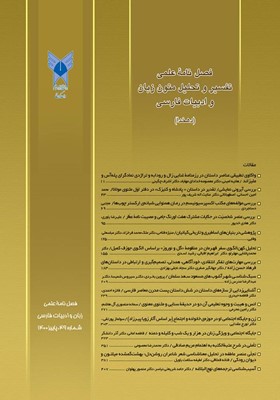تجلّی عنصر عاطفه در تحلیل معناشناسی شعر شاعران روشندل: بهشتگمشده میلتون و دیوان رودکی
محورهای موضوعی : متون زبان و ادبیات فارسیفتانه قملاقی 1 , لطیفه سلامت باویل 2
1 - دانشجوی دکتری گروه زبان و ادبیات فارسی، واحد تهران مرکزی، دانشگاه آزاد اسلامی، تهران، ایران.
2 - استادیار گروه زبان و ادبیات فارسی، واحد تهران مرکزی، دانشگاه آزاد اسلامی، تهران، ایران.
کلید واژه: احساس و عاطفه, جان میلتون, رودکی, تخیّل, بهشتگمشده,
چکیده مقاله :
رسالت اصلی ادبیّات بهویژه صورت منظوم آن، تأثیرگذاری بر احساس مخاطب است. شعر، معمولاً بازتابی از وضعیّت عاطفی خالق خویش است. بنابراین عنصر احساس و عاطفه بهعنوان یکی از ارکان معنوی شعر، مهمترین عنصر سازندۀ هنری است و پلی میان جنبۀ درونی و محیط بیرونی خالق اثر است که بیشترین تأثیر را بر مخاطب میگذارد؛ بدین جهت بررسی و تحلیل این عنصر نسبت به عناصر دخیل دیگر، ضروری بهنظر میرسد. هدف از پژوهش حاضر شناخت مضامین و افکار دو شاعر روشندل، جان میلتون و رودکی، با توجّه به احساس مشترک که برخواسته از نقص فیزیکی بین دو شاعر است، میباشد؛ چنانکه تفاوتها و تشابهات فکری آنان میتواند به شناخت بیشتر منجر شود و نیز به تعاملات میان فرهنگی در جهت نزدیکی تمدّنها و صلح جهانی کمک کند. پژوهش حاضر بر آن است تا چگونگی راههای انتقال عواطف، احساسات، القای معانی و هنر شاعری نظیر تشبیه، استعاره، حسآمیزی و تصویرسازی توأم با آن و... را با استفاده از روش توصیفی– تحلیلی مورد بررسی قرار دهد. یافتهها نشان داد که حسآمیزی و وجود عنصر عاطفه، عمدهترین نقطۀ اشتراک میان دو اثر و دو شاعر است. این وجه هر دو شاعر را زمانی میتوان قویتر مشاهده نمود که دریابیم حس نابینایی هر دوی آنها نه تنها محدودیتی در کارشان ایجاد نکرده، بلکه توانسته است تمایزاتی میان این دو شاعر با شعرایی که از حس بینایی برخوردار هستند، ایجاد نماید.
The main duty of literature is to affect audiences’ emotions. Poem is often a reflection of its creator’s emotional state. Thus, affection as one of the spiritual elements of poem is considered the most important artistic constituent. It is as a bridge connecting the outer and inner aspects of its creator that has the greatest influence on the audience; In this respect, it seems vital to analyze and investigate the aforementioned element compared to other effective ones. This study aims to recognize the two sightless poets’ themes and thoughts in terms of common affection that is due to their physical defects; differences and similarities of their perspectives could lead to more understanding and to help intercultural interactions, affinity of civilizations and betterment of the world piece. In this study through a descriptive-analytical approach, we intends to investigate the ways to transfer affections, emotions, induction of meaning as well as poetic tools such as simile, metaphor, sensuality and illustration. Our findings show sensuality or the element of affection is the main commonality between the two poets. This element is more rigorous when one realizes that their blindness not only has not caused limitations, but also has enabled them to be distinctive from other sighted poets.
کتاب ها
بورنوف، رولان و رئال اوئله (1378) جهان رمان، مترجم نازیلا خلخالی، تهران: مرکز.
تولستوی، لنون (1382) هنر چیست؟، ترجمۀ کاوه دهگان، چاپ یازدهم، تهران: انتشارات معین.
رودکی، ابوعبدالله محمّدبن جعفر(1382)، محیط زندگی و احوال و اشعار رودکی،چاپ چهارم، تصحیح سعید نفیسی، تهران: امیرکبیر.
السقطی، رسمیةموسی( 1966 م) أثر کفّ البصر علی الصورة عند أبی العلاء المعری، بغداد: مطبعه أسعد.
شفیعی کدکنی، محمدرضا (1376) موسیقی شعر، چاپ پنجم، تهران: انتشارات آگاه.
شفیعی کدکنی، محمدرضا (1383) ادوار شعر فارسی، تهران: نشر سخن.
فتحی، چیمن؛ محرمی، رامین (1394) همسویی حماسه ها: ایمان ترجمه، چاپ اول، سقز: نشر گوتار.
مجتبایی، فتح الله (1369) دایرةالمعارف بزرگ اسلامی، جلد 1، تهران: مرکز دایره المعارف بزرگ اسلامی.
میلتون، جان (1393) بهشتگمشده، مترجم مهدوی دامغانی، چاپ 1، جلد2، تهران: نشر ذهن آویز.
مقالات
ابراهیم تبار بورا، ابراهیم (1389) تشبیه در اشعار رودکی، پژوهش نامۀ ادبیات تعلیمی (پژوهشنامۀ زبان و ادبیات فارسی)، دورۀ 2، شمارۀ 5، صص 77-102.
حصارکی، محمدرضا، لاجوردی زاده، سیده شبنم (1396) ابزارهای بلاغی و دستوری توصیف در غزلهای سعدی شیرازی، فصلنامۀ علمی-تخصصی مطالعات زبان و ادبیات غنایی، سال 7، شمارۀ 24، صص 25-36.
فلاح، غلامعلی(1395) ساختار اشعار رودکی، مجلۀ متن شناسی ادبی فارسی، سال هشتم، شمارۀ 4، پیاپی 32، صص 15-28. کرامتی مقدم، سید علی (1394) تشبیه مهم ترین عنصر خیال و تصویرآفرینی در شعر رودکی، نشریه مطالعات زبانی بلاغی، پیاپی ۱۲، صص 137-160.
_||_Books
Bornov, Roland and Real O'Leary (1999) Jahan Roman, translated by Nazila Khalkhali, Tehran: Markaz.
Tolstoy, Lennon (2003) What is Art ?, translated by Kaveh Dehgan, 11th edition, Tehran: Moin Publications.
Roudaki, Abu Abdullah Mohammad Ibn Jafar (2003) Roudaki's living environment and conditions, fourth edition, edited by Saeed Nafisi, Tehran: Amirkabir.
Al-Saqqati, Al-Musa (1966) The effect of the palm of the eye on the image with Abi Al-Ala Al-Ma'ari, Baghdad: Assad Press.
Shafiee Kadkani, Mohammad Reza (1997) Poetry Music, Fifth Edition, Tehran: Agah Publications.
Shafiee Kadkani, Mohammad Reza (2004) Persian Poetry Periods, Tehran: Sokhan Publishing.
Fathi, Chimen; Moharremi, Ramin (2015) Alignment of Epics: Iman Translation, First Edition, Saqez: Gutar Publishing.
Mojtabaei, Fathollah (1990) The Great Islamic Encyclopedia, Volume 1, Tehran: The Great Islamic Encyclopedia Center.
Milton, John (2014) Paradise Lost, translated by Mahdavi Damghani, 1st edition, Volume 2, Tehran: Mind Publishing.
Articles
Ebrahim Tabar Bora, Ebrahim (2010) Simile in Rudaki's Poems, Research Literature Research Journal (Journal of Persian Language and Literature), Volume 2, Number 5, pp. 77-102.
Hesaraki, Mohammad Reza, Lajevardizadeh, Seyedeh Shabnam (2017) Rhetorical and grammatical tools of description in Saadi Shirazi lyric poems, Quarterly Journal of Linguistic Language and Literature Studies, Volume 7, Number 24, pp. 25-36.
Fallah, Gholam Ali (2016) The Structure of Rudaki Poems, Journal of Persian Literary Textology, Year 8, Number 4, Consecutive 32, pp. 15-28.
Keramati Moghadam, Seyed Ali (2015) The simile of the most important element of imagination and illustration in Roudaki's poetry, Journal of Rhetorical Linguistic Studies, 12 consecutive, pp. 137-160.


